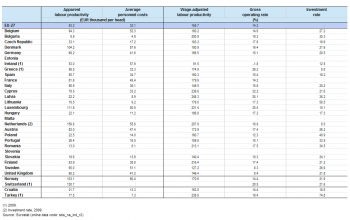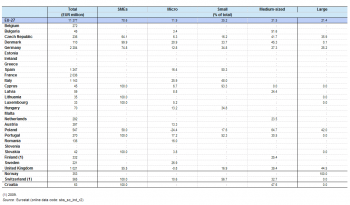Archive:Other mining and quarrying statistics - NACE Rev. 2
This Statistics Explained article is outdated and has been archived - for recent articles on structural business statistics see here.
- Data from April 2013. Most recent data: Further Eurostat information, Main tables and Database.
This article presents an overview of statistics for other mining and quarrying in the European Union (EU), covering NACE Rev. 2 Division 08.


(% share of sectoral total) - Source: Eurostat (sbs_na_ind_r2)







(% share of sectoral total) - Source: Eurostat (sbs_sc_ind_r2)


Main statistical findings
Structural profile
The EU-27’s other mining and quarrying sector (Division 08) comprised 18 thousand enterprises in 2010, employed 214 thousand persons, and generated EUR 11.4 billion of value added. As such, this sector contributed 0.2 % of the EU-27’s non-financial business economy (Sections B to J and L to N and Division 95) employment and value added, while its contribution to mining and quarrying (Section B) was 34.8 % of the workforce and 13.5 % of value added.
Apparent labour productivity in the EU-27’s other mining and quarrying sector was EUR 53.2 thousand per person employed in 2010, somewhat above the non-financial business economy average of EUR 44.8 thousand per person employed but equivalent to less than half the mining and quarrying average of EUR 137.0 thousand per person employed. Average personnel costs within the EU-27’s other mining and quarrying sector were EUR 32.1 thousand per employee in 2010, which was between the average for the non-financial business economy (EUR 30.9 thousand per employee) and the average for mining and quarrying (EUR 37.5 thousand per employee).
The wage-adjusted labour productivity ratio combines the two previous indicators and shows that value added per person employed was equivalent to 165.7 % of average personnel costs per employee in the EU-27’s other mining and quarrying sector in 2010. As such, the value for this sector was again closer to the non-financial business economy average (144.8 %) than to the mining and quarrying average (365.0 %). A broadly similar situation was observed for the gross operating rate, which was 14.2 % for other mining and quarrying, between the non-financial business economy average (10.1 %) and the mining and quarrying average (28.3 %).
Sectoral analysis
Around eight out of every nine (88.5 %) enterprises within the EU-27’s other mining and quarrying sector were classified under the quarrying of stone, sand and clay (Group 08.1), while the remainder were attributed to mining and quarrying not elsewhere classified (Group 08.2). In output and employment terms, the relative importance of quarrying of stone, sand and clay was slightly less, with 81.4 % of sectoral value added and 83.8 % of sectoral employment — see Figure 1.
Through its size, the relatively large subsector for the quarrying of stone, sand and clay dominates the other mining and quarrying sector; therefore, the values for many derived indicators for this subsector are generally close to the sectoral average. Apparent labour productivity for the quarrying of stone, sand and clay was EUR 51.5 thousand per person employed, whereas for mining and quarrying not elsewhere classified it reached EUR 62.0 thousand per person. In a similar manner, the gross operating rate for mining and quarrying not elsewhere classified (15.1 %) was somewhat higher than that for the quarrying of stone, sand and clay (14.0 %); both of these rates were above the non-financial business economy average (10.1 %) in 2010, but below the mining and quarrying average (28.3 %).
Country analysis
Germany recorded the highest share (19.4 %) of EU-27 value added within the other mining and quarrying sector in 2010, followed by France (17.9 %), Spain (11.0 %) and Italy (10.0 %). Germany’s position as the largest Member State in this sector was reinforced by having the highest value added in the mining and quarrying not elsewhere classified subsector (23.7 % of EU-27 value added), whereas France had the highest share (20.3 %) of value added within the larger quarrying of stone, sand and clay subsector.
The same four Member States (Germany, France, Spain and Italy) figured among the top five in terms of the largest workforces in the other mining and quarrying sector, although their shares of the EU-27 total were all smaller in employment terms — ranging from 14.9 % in Germany to 9.4 % in Italy — than they were in value added terms. The top five was completed by Poland, with an 11.3 % share of the EU-27 workforce, making it the third largest employer behind Germany and France.
In value added terms, the most specialised EU Member State in this sector in 2010 was Latvia, as 0.8 % of Latvian non-financial business economy value added was generated in the other mining and quarrying sector, four times the EU-27 average (0.2 %). Among all of the NACE divisions within the non-financial business economy, this sector ranked second for Latvia in terms of the sector’s contribution to non-financial business economy value added compared with the equivalent contribution for the EU-27 as a whole. The next most specialised Member State was Cyprus where this sector accounted for 0.5 % of non-financial business economy value added in 2010.
The highest wage-adjusted labour productivity ratios recorded within the other mining and quarrying sector in 2010 were in the Netherlands, Latvia, Cyprus and Luxembourg, all in excess of 220 %. Ireland (2009 data) was the only EU Member State where the wage-adjusted labour productivity ratio was below 100 %, as apparent labour productivity in Ireland was just 91.5 % of the average personnel costs — see Table 4b.
Size class analysis
In contrast to most of the mining and quarrying activities, the other mining and quarrying sector reported a relatively important role for small and medium-sized enterprises (SMEs, employing fewer than 250 persons). There were 17.8 thousand SMEs active within the EU-27’s other mining and quarrying sector in 2010. Together they generated EUR 8.9 billion of added value and employed 176 thousand persons. As such, they accounted for a 78.6 % share of value added within the EU-27’s other mining and quarrying sector and an 82.3 % share of employment.
An analysis of the relative shares of the three size classes within the SME heading shows that small enterprises (employing 10 to 49 persons) were particularly active in the other mining and quarrying sector, accounting for 35.2 % of sectoral value added and employing the same share of the workforce. Micro enterprises (employing fewer than 10 persons) contributed 11.9 % of the other mining and quarrying sector’s value added but employed 18.3 % of the workforce, indicating the lowest apparent labour productivity within this sector among the four size classes shown in Table 5. Conversely, apparent labour productivity was highest for large enterprises (employing 250 or more persons) which employed the smallest share of the workforce (17.7 %) but contributed one fifth (21.4 %) of value added.
Whether measured in value added or employment terms, SMEs contributed at least half of the sectoral total in all of the EU Member States with data available — see Tables 6a and 6b. The highest contributions from large enterprises were in the United Kingdom, accounting for 44.1 % of sectoral employment and 44.5 % of value added.
Data sources and availability
The analysis presented in this article is based on the main dataset for structural business statistics (SBS) and size class data, all of which are published annually.
The main series provides information for each EU Member State as well as a number of non-member countries at a detailed level according to the activity classification NACE. Data are available for a wide range of variables.
In structural business statistics, size classes are generally defined by the number of persons employed. A limited set of the standard structural business statistics variables (for example, the number of enterprises, turnover, persons employed and value added) are analysed by size class, mostly down to the three-digit (group) level of NACE. The main size classes used in this article for presenting the results are:
- small and medium-sized enterprises (SMEs): with 1 to 249 persons employed, further divided into;
- micro enterprises: with less than 10 persons employed;
- small enterprises: with 10 to 49 persons employed;
- medium-sized enterprises: with 50 to 249 persons employed;
- large enterprises: with 250 or more persons employed.
Context
This article presents an overview of statistics for the other mining and quarrying sector in the EU, covering NACE Rev. 2 Division 08. This division includes extraction from mines or quarries as well as dredging of alluvial deposits, rock crushing and the use of salt marshes. These products are used most notably in construction (for example, sands and stones), chemicals and materials manufacturing (for example, clay, gypsum and calcium).
Other mining and quarrying not elsewhere classified includes, for example, the mining and quarrying of abrasive materials, asbestos, natural graphite, steatite (talc), feldspar, natural asphalt, gemstones, quartz and mica.
This NACE division is composed of two groups:
- the quarrying of stone, sand and clay (Group 08.1);
- mining and quarrying not elsewhere classified (Group 08.9).
This division does not include processing (except crushing, grinding, cutting, cleaning, drying, sorting and mixing) of the minerals extracted.
See also
- Mining and quarrying
- Other analyses of the business economy by NACE Rev. 2 sector
- Structural business statistics introduced
Further Eurostat information
Publications
- European business - facts and figures (online publication)
- Key figures on European Business – with a special feature section on SMEs – 2011 edition
Main tables
Database
- SBS - industry and construction (sbs_ind_co)
- Annual detailed enterprise statistics - industry and construction (sbs_na_ind)
- Annual detailed enterprise statistics for industry (NACE Rev. 2 B-E) (sbs_na_ind_r2)
- SMEs - Annual enterprise statistics by size class - industry and construction (sbs_sc_ind)
- Industry by employment size class (NACE Rev. 2 B-E) (sbs_sc_ind_r2)
- Annual detailed enterprise statistics - industry and construction (sbs_na_ind)
- SBS - regional data - all activities (sbs_r)
- SBS data by NUTS 2 regions and NACE Rev. 2 (from 2008 onwards) (sbs_r_nuts06_r2)
Dedicated section
Source data for tables and figures (MS Excel)
Other information
- Decision 1578/2007/EC of 11 December 2007 on the Community Statistical Programme 2008 to 2012
- Regulation 295/2008 of 11 March 2008 concerning structural business statistics